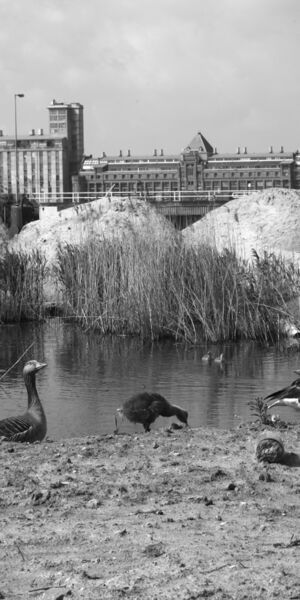Zoöp
zoöp
The sound of the desperate voices of collectives of animals, plants, and other bodies alive today can be harsh to the senses, and it demands an effort and dedication to take those voices into account.[3] The Zoöp way of working aims to concretize this effort. It has three goals: firstly, to strengthen the political and legal standing of other-than-human life within human capitalist societies. Secondly, to support ecological regeneration, in Zoöp vocabulary: Zoöps want to develop the zoönomy (a regenerative economy that secures the quality of life of multispecies collectivities) within and surrounding Zoöps. Thirdly, the aim of the initiators is to make the Zoöp model widely adoptable and put into practice by a variety of organizations, from farms to municipalities, from hotels to cemeteries, from commercial enterprises to non-profit organizations. The Zoöp model is the centrepiece of the Zoöp movement and shapes anchoring bodies for the larger practice of zoönomy.
In order to facilitate the development of the Zoöp movement, two legal bodies have been founded in 2022. One is the Zoönomic Institute. Its task is to help organizations to transform themselves into Zoöps. It grants organizations the right to call themselves Zoöps. The other one is the Zoönomic Foundation. As laid down in its statutes, the Zoönomic Foundation has one task only: to articulate and represent the needs and interests of other-than-human life in the spatial and operational domain of Zoöps and to translate these into organizational decision making.
Organizations that turn into a Zoöp keep their existing function—a school remains a school, a farm remains a farm, a hotel a hotel—but set themselves an additional goal, which is to foster zoönomy. An organization can be be accredited as Zoöp[4] by doing two things: first it grants the Zoönomic Foundation an observer seat on its board (or whatever body in charge of its policies). This seat is then filled by a human Speaker for the Living. The Speaker for the Living is bound to the statutes of the Zoönomic Foundation and acts as the speculative and political organ for other-than-human life in the Zoöp. Secondly, the organization commits itself to follow the Zoönomic annual cycle, by which it gradually transforms its operation, intervention
The development of the Zoöp concept was inspired by the now famous Rights of Nature cases of Whanganui river, Mount Taranaki, and Te Urewera forest. These three collective other-than-human bodies are the living ancestors of different New Zealand Iwi, tribes of the Maori, New Zealand’s indigenous people. The river, mountain, and forest were granted legal personhood in the New Zealand jurisdiction between 2014 and 2017. In legal terms, they became incorporated other-than-humans. Whenever necessary, they are represented by human members of their respective Iwi.
In Western cultural tradition, collective bodies of other-than-humans do not have the status of ancestors. In fact, they are not even considered subjects, but resources, which caused the ecological disaster we find ourselves in. Although there is a growing movement of Rights of Nature legal and other activists, the legislative reform by which living other-than-humans should gain rights will be slow and thorny.
The Zoöp organizational format does not require the legislative reform that rights of nature require, but uses existing instruments of private law. Zoöp does not grant rights or personhood to living other-than-human entities but operates on the premise of them already having rights. Zoöp is intended as a way of organizing, a practice, a procedure that actively acknowledges these rights and the subjective experience of other-than-human life. It is focused on collaboration between human and other-than-human life. In this sense, the Zoöp model is a pragmatic shortcut to a Rights of Nature
With the governance structure and the Zoönomic Foundation in place, a Zoöp, commits itself to figuring out how its operation can transform itself into a regenerative practice, contributing to the quality of life of a human inclusive ecology. It does so by following the Zoönomic annual cycle of four movements, called Demarcating, Observing & Sensing, Characterizing and Intervening.[6]
Demarcating answers the question: which (legal, human, organizational, and other-than-human) bodies form the Zoöp?[7] Demarcating situates the Zoöp’s practice in its environment and articulates its locally specific questions for actual ‘collective bodies’.
Observing & Sensing is concerned with understanding the life-worlds of the different bodies that make up a Zoöp, and with the question of whether and how those bodies perceive and acknowledge each other’s Zoöp participation.
Characterizing involves asking the question how the different bodies enhance or obstruct each other’s quality of life. This will result in a first kind-of-diagnosis of the Zoöp’s ecological integrity and exploration of interventions.
Intervening, then, is the process of actually changing the spatial arrangements, organizational practice or relational fabric of a Zoöp. Its primary objective is a local, thriving, combined human and other-than-human community that provides groundwork for other, more global aspects of the transformation of economy into zoönomy.
At the time of writing, more than twenty organizations (farms, cultural institutions, holiday parks, educational institutions and others) have committed themselves to becoming a Zoöp. On 22 April 2022, Earth Day, Het Nieuwe Instituut in Rotterdam has become the first actual Zoöp in the world.
- ↑ Federico Campagna, Technic & Magic: The Reconstruction of Reality (London, etc.: Bloomsbury Academic, 2018).
- ↑ Mark Fisher, Capitalist Realism: Is There No Alternative? (Hampshire: John Hunt Publishing, 2009).
- ↑ Eva Meijer, Dierentalen (Leusden: ISVW Uitgevers, 2020).
- ↑ So, by the Zoönomic Institute, the central hub of the zoöp movement.
- ↑ See for instance www.therightsofnature.org/what-is-rights-of-nature/.
- ↑ zoop.hetnieuweinstituut.nl/instruments-methods.
- ↑ Adopted and expanded from Elinor Ostrom’s principles for managing commons onthecommons.org/magazine/elinor-ostroms-8-principles-managing-commmons, www.onthecommons.org/magazine/elinor-ostroms-8-principles-managing-commons.
